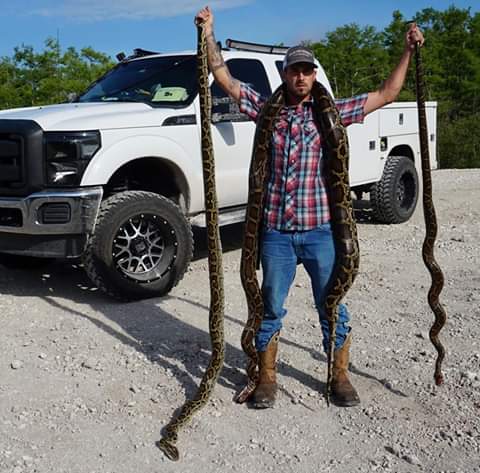I tell ya folks, I have been quite tickled at the great response from last week’s column. That so many of you took the time to write me about it, struck me as awfully nice. And to answer a few of your queries I’m going to expound a bit about our python hunting adventure and hopefully satisfy your curiosities.
The first few questions and the ones most frequently asked are easy to satisfy. First, no my partner on this expedition, Miss Meghan Bailes, is not crazy. She is fearless, but of sound mind, I assure you. She readily jumped at the chance to handle the wild serpents but did so under the supervision and tutelage of a trained professional with many years of experience. Second, no I’m not a sissy. I just don’t like snakes and have had a very poor encounter with one of the poisonous variety, which gives me plenty of reason to not want to handle any live ones. I promise you, I am secure enough in my manhood to pass that task to a girl. And third, no our guide for the weekend, Mike Kimmel, Of Martin County Trapping and Wildlife Rescue, does not provide guided tours of the Everglades for the purpose of catching invasive species. Which is really a shame, as he is a gentleman and a wealth of information on South Florida’s varied ecosystems.
Another question many of you asked, has been how long have these big snakes called Florida home? The Burmese pythons (Python bivittatus), which as a species are native throughout Southeast Asia, were first sighted in Everglades National Park in the 1980s. However, it wasn’t until 2000, that they were officially recognized as a reproducing population. Only nineteen years later the population estimates range anywhere from 300,000 snakes all the way up to a million, depending on whom you’re asking.
One thing that sets the big snakes apart from any of our native species is their diet. There really isn’t much they won’t consume; birds, turtles, fish, and any fur-bearing mammals, on up to alligators, deer, and livestock up to about 200 pounds. Mike Kimmel pointed out during our visit that the Glades used to be full of life, raccoons, opossums, rabbits, etc, in abundance. Nowadays, he tells me, the wildlife sightings are rare. The pythons are reducing the Everglades to a wasteland and that is why so many groups, such as the South Florida Water Management District and the Florida Wildlife Commission, are spending millions of dollars on research and programs designed to bring the numbers of these alpha predators under control.
I will be returning to the Everglades soon, most likely with my fearless friend Meghan, in tow to hunt a collection of private farms for the pythons. There have been many sightings in the area and quite a bit of livestock has been lost to their coils. I will be honored to assist in the hunt to reduce the encroaching numbers, but this time I’ll be allowed to shoot them. And to be sure, I rather prefer it that way!
For any of you getting outdoors this weekend, I wish you the best of luck! And as always, I’d love to hear about your adventures and maybe see a photo or two of your successes at [email protected]. God bless and good hunting!

